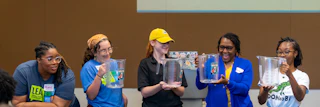

Activity 1.4
Our Water
People with different wants and needs require different relationships with the environment. Each person’s actions can have an impact on the quality and quantity of land, water, air, and shelter for others around them.
Standards
Anchor Standard - SL1
Prepare for and participate effectively in a range of conversations and collaborations with diverse partners, building on others’ ideas and expressing their own clearly and persuasively.
Kindergarten
K.6
Identify cause and effect for a significant event in a school, neighborhood, or parish.
K.8a
Describe the importance of fairness, responsibility, respect, and hard work. For example, taking care of personal belongings and respecting the property of others.
K.11
Explain how people can work together to make decisions.
K.17
Describe the concept of scarcity using examples
Grade 1
1.15a
Describe the importance of fairness, responsibility, respect, and hard work. For example, taking care of personal belongings and respecting the property of others.
1.21
Describe how scarcity requires people to make choices.
Grade 2
2.18
Explain how scarcity of resources and opportunity costs require people to make choices to satisfy wants and needs.
2.19
Identify how people use natural (renewable and non-renewable), human, and capital resources to provide goods and services.
Grade 3
3.16
Identify how people use natural (renewable and non-renewable),human, and capital resources to provide goods and services.
3.17
Describe the relationship between scarcity and opportunity cost in economic decision-making.
Kindergarten
K-ESS3-3
Communicate solutions that will reduce the impact of humans on the land, water, air, and/or other living things in the local environment.
Grade 5
5-ESS3-1
Generate and compare multiple solutions about ways individual communities can use science to protect the Earth’s resources and environment.
Grade 8
8-MS-ESS3-3
Apply scientific principles to design a method for monitoring and minimizing human impact on the environment.
Earth Science
HS-ESS3-4
Evaluate or refine a technological solution that reduces the impacts of human activities on natural systems.
Environmental Science
HS-EVS3-1
Construct and evaluate arguments about the positive and negative consequences of using disposable resources versus reusable resources.
HS-ESS3-4
Evaluate or refine a technological solution that reduces the impacts of human activities on natural systems.
Materials
- A clear cup for each student
- A pitcher for each group of students that has measurement markings on the side
- Clean and clear water
- Food coloring (contamination)
- Our Water Activity cards
Instructions
- Group students into groups of 5-6, and have them sit together. Each group needs a pitcher of water, a cup for each student, and a deck of activity cards. Note: Each group should have the same amount of water in their pitcher.
- Have each group note how much water is in their pitcher. The goal of the activity is for the entire group to work together to preserve as much clean water as possible.
- Each student should have a cup in front of them. The teacher or a group leader will pour water from the pitcher into each cup, making sure to distribute different amounts of water in each cup. All of the water should be used.
- The activity cards should be face-down in the middle of the group. One person at a time takes an activity card from the top of the deck and reads it aloud to their group. They then follow the directions.
- Moving to the left around the circle/table, each person should draw a card and follow the directions until all the cards are gone or everyone has drawn three times.
- When finished, pour all the clean, clear water back into the pitcher to see how much is left compared to the beginning of the activity.
Reflection Questions
- How much water is left?
- What actions could you control to keep the water clean? What actions could you NOT control?
- How could the group work together better to preserve more clean water?

